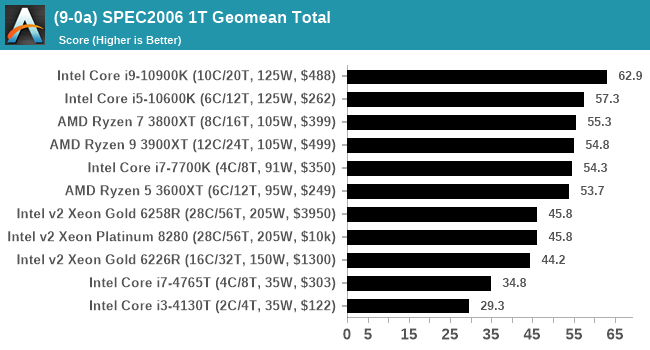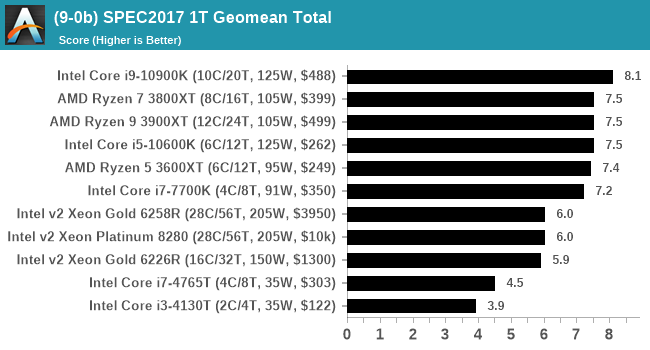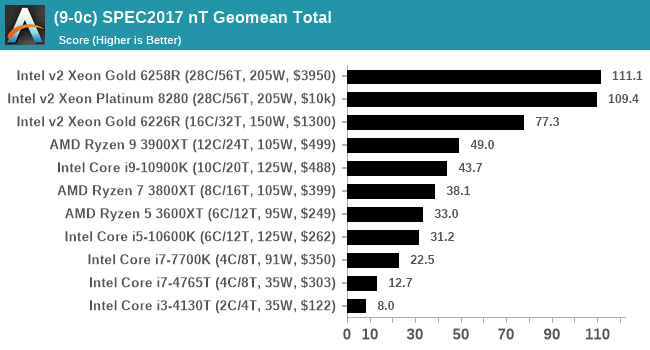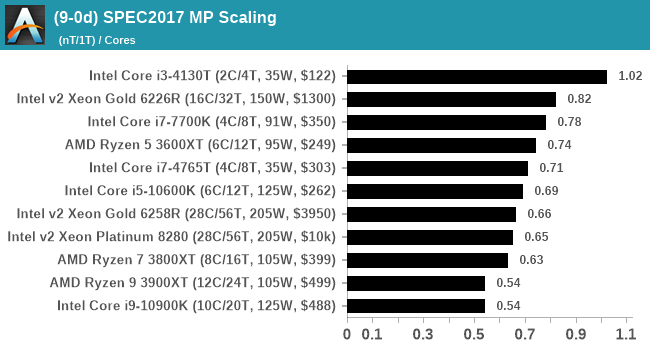Launching the #CPUOverload Project: Testing Every x86 Desktop Processor since 2010
by Dr. Ian Cutress on July 20, 2020 1:30 PM ESTCPU Tests: SPEC2006 1T, SPEC2017 1T, SPEC2017 nT
SPEC2017 and SPEC2006 is a series of standardized tests used to probe the overall performance between different systems, different architectures, different microarchitectures, and setups. The code has to be compiled, and then the results can be submitted to an online database for comparison. It covers a range of integer and floating point workloads, and can be very optimized for each CPU, so it is important to check how the benchmarks are being compiled and run.
We run the tests in a harness built through Windows Subsystem for Linux, developed by our own Andrei Frumusanu. WSL has some odd quirks, with one test not running due to a WSL fixed stack size, but for like-for-like testing is good enough. SPEC2006 is deprecated in favor of 2017, but remains an interesting comparison point in our data. Because our scores aren’t official submissions, as per SPEC guidelines we have to declare them as internal estimates from our part.
For compilers, we use LLVM both for C/C++ and Fortan tests, and for Fortran we’re using the Flang compiler. The rationale of using LLVM over GCC is better cross-platform comparisons to platforms that have only have LLVM support and future articles where we’ll investigate this aspect more. We’re not considering closed-sourced compilers such as MSVC or ICC.
clang version 10.0.0
clang version 7.0.1 (ssh://git@github.com/flang-compiler/flang-driver.git
24bd54da5c41af04838bbe7b68f830840d47fc03)-Ofast -fomit-frame-pointer
-march=x86-64
-mtune=core-avx2
-mfma -mavx -mavx2
Our compiler flags are straightforward, with basic –Ofast and relevant ISA switches to allow for AVX2 instructions. We decided to build our SPEC binaries on AVX2, which puts a limit on Haswell as how old we can go before the testing will fall over. This also means we don’t have AVX512 binaries, primarily because in order to get the best performance, the AVX-512 intrinsic should be packed by a proper expert, as with our AVX-512 benchmark.
To note, the requirements for the SPEC licence state that any benchmark results from SPEC have to be labelled ‘estimated’ until they are verified on the SPEC website as a meaningful representation of the expected performance. This is most often done by the big companies and OEMs to showcase performance to customers, however is quite over the top for what we do as reviewers.
For each of the SPEC targets we are doing, SPEC2006 rate-1, SPEC2017 speed-1, and SPEC2017 speed-N, rather than publish all the separate test data in our reviews, we are going to condense it down into individual data points. The main three will be the geometric means from each of the three suites.



A fourth metric will be a scaling metric, indicating how well the nT result scales to the 1T result for 2017, divided by the number of cores on the chip.

The per-test data will be a part of Bench.
Experienced users should be aware that 521.wrf_r, part of the SPEC2017 suite, does not work in WSL due to the fixed stack size. It is expected to work with WSL2, however we will cross that bridge when we get to it. For now, we’re not giving wrf_r a score, which because we are taking the geometric mean rather than the average, should not affect the results too much.










110 Comments
View All Comments
Smell This - Monday, July 20, 2020 - link
;- )
Oxford Guy - Monday, July 20, 2020 - link
"If there’s a CPU, old or new, you want to see tested, then please drop a comment below."• i7-3820. This one is especially interesting because it had roughly the same number of transistors as Piledriver on roughly the same node (Intel 32nm vs. GF 32 nm).
• 5775C
• 5675C (which outperformed and matched the 5775C in some games due to thermal throttling)
• 5775C with TDP bypassed or increased if this is possible, to avoid the aforementioned throttling
• I would really really like you to add Deserts of Kharak to your games test suite. It is the only game I know of that showed Piledriver beating Intel's chips. That unusual performance suggests that it was possible to get more performance out of Piledriver if developers targeted that CPU for optimization and/or the game's engine somehow simply suited it particularly.
• 8320E or 8370E at 4.7 GHz (non-turbo) with 2133 CAS 9-11-10 RAM, the most optimal Piledriver setup. The 9590 was not the most performant of the FX line, likely because of the turbo. A straight overclock coupled with tuned RAM (not 1600 CAS 10 nonsense) makes a difference. 4.7 GHz is a realistic speed achievable by a large AIO or small loop. If you want air cooling only then drop to 4.5 Ghz but keep the fast RAM. The point of testing this is to see what people were able to get in the real world from the AMD alternative for all the years they had to wait for Zen. Since we were stuck with Piledriver as the most performant Intel alternative for so so many years it's worth including for historical context. The "E" models don't have to be used but their lower leakage makes higher clocks less stressful on cooling than a 9000 series. 4.7 GHz was obtainable on a cheap motherboard like the Gigabyte UD3P, with strong airflow to the VRM sink.
• VIA's highest-performance model. If it won't work with Windows 10 then run the tests on it with 8.1. The thing is, though... VIA released an update fairly recently that should make it compatible with Windows 10. I saw Youtube footage of it gaming, in fact, with a discrete card. It really would be a refreshing thing to see VIA included, even though it's such a bit player.
• Lynnfield at 3 GHz.
• i7-9700K, of course.
Oxford Guy - Monday, July 20, 2020 - link
Regarding Deserts of Kharak... It may be that it took advantage of the extra cores. That would make it noteworthy also as an early example of a game that scaled to 8 threads.Oxford Guy - Monday, July 20, 2020 - link
Also, the Chinese X86 CPU, the one based on Zen 1, would be very nice to have included.Oxford Guy - Monday, July 20, 2020 - link
VIA CPUs tested with games as recently as 2019 (there was another video of the quad core but I didn't find it today with a quick search):https://www.youtube.com/watch?v=JPvKwqSMo-k
https://www.youtube.com/watch?v=Da0BkEW459E
The Zhaoxin KaiXian KX-U6880A would be nice to see included, not just the Chinese Zen 1 derivative.
Oxford Guy - Monday, July 20, 2020 - link
"due to thermal throttling"TDP throttling, to be more accurate. I suppose it could throttle due to current demand rather than temp.
axer1234 - Monday, July 20, 2020 - link
honestly i would love to know how different generation processor perform today especially higher core count. like prescott series pentium 4 athlon II phenomX6 core2 duo core2quad nehlam sandy bridge bulldozer etc with todays generation work loads and offeringin many scenario like word excel ppt photoshop it all works very well still in many offices
its just the new generation of application slowing it down for almost the same work etc
herefortheflops - Monday, July 20, 2020 - link
@Dr. Cutress.,As someone that has been dealing with similar or greater product testing challenges and configuration complexity for the better part of a decade or so, I would like to commend you for your ambitious goals and efforts so far. Additionally, I could be of high value to your effort if you are willing to discuss. I have reviewed in-depth the bench database (as well as competing websites) and I have come to the conclusion the Anandtech bench data is of very limited usefulness at present--and would require some significant changes to the data being collected/reported and the way things have been done to this point. I do understand where the industry is going, the questions the readers are going to be asking of the data, and the major comparisons that will be attempted with the data. Unfortunately, much of your effort may easily become irrelevant unless you proceed with some extreme caution to provide data with more utility. I also know methods to accomplish the desired result while reducing the size and cost of the task at hand. Reply by e-mail if you are interested in talking.
Best,
-A potential contributor to your effort.
Bensam123 - Tuesday, July 21, 2020 - link
Despite how impressive this is, one thing that hasn't been tackled is still multiplayer performance and it vastly changes recommendations for CPUs (doesn't effect GPUs as much).It goes from recommending a 6 core chip hands down to trying to make a case for 4 core chips still in this day and age. I own a 3900x and 2800 and I can tell you hands down Modern Warfare will gobble 70% of that 12 core chip, sometimes a bit more, that's equivalent to maxing out a 8 core of the same series. That vastly changes recommendations and data points. It's not just Modern Warfare. Overwatch, Black Ops 3(same engine as MW), and recently Hyper Scape will will make use of those extra cores. I have a widget to monitor CPU utilization in the background and I can check Task Manager. If I had a better video card I'm positive it would've sucked down even more of those 12 cores (my GPU is running at 100% load according to MSI AB).
This is a huge deal and while I understand, I get it, it's hard to reliably reproduce the same results in a multiplayer environment because it changes so much and generally seen as taboo from a hardware benchmarking standpoint, it is vastly different then singleplayer workloads to the point at which it requires completely different recommendations. Given how many people are making expensive hardware choices specifically because they play multiplayer games, I would even say most tech reviews in this day and age are irrelevant for CPU recommendations outside of the casual single player gamer. GPU recommendations are still very much on par, CPU is not remotely.
I talk about this frequently on my stream and why I still recommended the 1600 AF even when it was sitting at $105-125, it's a steal if you play multiplayer games, while most people that either read benchmarking websites or run benchmarks themselves will start making a case for a 4c Intel. 6 core is a must at the very least in this day and age.
Anandtech it's time to tread new ground and go into the uncharted area. Singleplayer results and multiplayer results are too different, you can't keep spinning the wheel and expect things to remain the same. You can verify this yourself just by running task manager in the background while playing one of the games I mentioned at the lowest settings regardless of being able to repeat those results exactly you'll see it's definitely a multi-core landscape for newer multiplayer games.
Not even touched on in the article.
Bensam123 - Tuesday, July 21, 2020 - link
70%, I have SMT off for clarification.